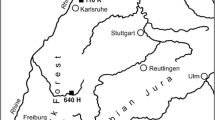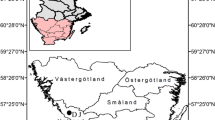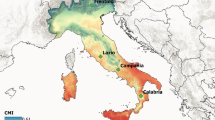Abstract
Increasing summer droughts represent a major threat for the vitality and productivity of forests in the temperate zone. European beech, the most important tree species of Central Europe’s natural forest vegetation, is known to suffer from increased drought intensity at its southern distribution limits, but it is not well known how this species is affected in the center of its distribution range in a sub-oceanic climate. We compared tree-ring chronologies and the climate sensitivity of growth (MS) in 11 mature beech stands along a precipitation gradient (855–576 mm y−1) on two soil types with contrasting water storage capacity (WSC) in northwest Germany to test the hypotheses that recent warming is impairing beech growth also in the center of its distribution below a certain precipitation limit, and stands with low soil WSC are more susceptible. We found a threshold of about 350 mm of mean growing season precipitation below which basal area increment (BAI) showed a consistent decline since the 1970s. The frequency of negative pointer years and MS were highest in low-precipitation stands on sandy soil, but both parameters have increased during the last decades also in the moister stands. The factor with largest impact on BAI was precipitation in June, in combination with high mid-summer temperatures. Contrary to our hypothesis, the edaphic effect on growth dynamics was surprisingly small. We conclude that global warming-related growth decline is affecting European beech even in the center of its distribution below a hydrological threshold that is mainly determined by mid-summer rainfall.







Similar content being viewed by others
REFERENCES
Allen CD, Macalady AK, Chenchouni H, Bachelet D, McDowell N, Vennetier M et al. 2010. A global overview of drought and heat-induced tree mortality reveals emerging climate change risks for forests. For Ecol Manag 259:660–4.
Alvarez-Uria P, Körner C. 2007. Low temperature limits of root growth in deciduous and evergreen temperate tree species. Funct Ecol 21:211–18.
Babst F, Poulter B, Trouet V, Tan K, Neuwirth B, Wilson R et al. 2013. Site- and species-specific responses of forest growth to climate across the European continent. Glob Ecol Biogeogr 22:706–17.
Baillie MGL, Pilcher JR. 1973. A simple crossdating program for tree-ring research. Tree Ring Bull 33:7–11.
Beck W. 2009. Growth patterns of forest stands-the response towards pollutants and climatic impact. iFor Biogeosci For 2:4–6.
Beck W. 2011. Impact of drought and heat on tree and stand vitality—results of the study commissioned by the Federal Ministry of Food, Agriculture and Consumer Protection. In: Maaten-Theunissen M, Spiecker H, Gärtner H, Helle G, Heinrich I, Eds. TRACE—tree rings in archaeology, climatology and ecology. GFZ: Potsdam. p 20–7.
Beck W, Heußner KU. 2012. Increased sensitivity in ring width series of common beech after 1990—climatic impact or normal patterns due to ageing? Dendrosymposium 10:13–19.
Biondi F. 1993. Climatic signals in tree rings of Fagus sylvatica L. from the central Apennines, Italy. Acta Oecol 14:57–71.
Biondi F. 1999. Comparing tree-ring chronologies and repeated timber inventories as forest monitoring tools. Ecol Appl 9:216–27.
Biondi F, Qeadan F. 2008. A theory-driven approach to tree-ring standardization: defining the biological trend from expected basal area increment. Tree Ring Res 64:81–96.
BMEL. 2014. Der Wald in Deutschland – Ausgewählte Ergebnisse der dritten Bundeswaldinventur. Berlin: Bundesministerium für Ernährung und Landwirtschaft.
BMU. 2011. Beech forests—UNESCO World Natural Heritage. Berlin: Bundesministerium für Umwelt, Naturschutz, Bau und Reaktorsicherheit.
Bouriaud O, Bréda N, Dupouey JL, Granier A. 2005. Is ring width a reliable proxy for stem-biomass increment? A case study in European beech. Can J For Res 35:2920–33.
Bréda N, Badeau V. 2008. Forest tree responses to extreme drought and some biotic events: towards a selection according to hazard tolerance? C R Geosci 340:651–62.
Bréda N, Huc R, Granier A, Dreyer E. 2006. Temperate forest trees and stands under severe drought: a review of ecophysiological responses, adaptation processes and long-term consequences. Ann For Sci 63:625–44.
Briffa KR, Jones PD, Schweingruber FH, Karlén W, Shiyatov SG. 1996. Tree-ring variables as proxy-climate indicators: problems with low-frequency signals. In: Jones PD, Bradley RS, Jouzel J, Eds. Climatic variations and forcing mechanisms of the last 2000 years. Heidelberg: Springer. p 9–41.
Briffa KR, Osborn TJ, Schweingruber FH, Harris IC, Jones PD, Shiyatov SG, Vaganov EA. 2001. Low-frequency temperature variations from a northern tree ring density network. J Geophys Res 106:2929–41.
Bunn AG, Jansma E, Korpela M, Westfall RD, Baldwin J. 2013. Using simulations and data to evaluate mean sensitivity (ζ) as a useful statistic in dendrochronology. Dendrochronologia 31:250–4.
Carsjens C, Nguyen Ngoc Q, Guzy J, Knutzen F, Meier IC, Müller M et al. 2014. Intra-specific variations in expression of stress-related genes in beech progenies are stronger than drought-induced responses. Tree Physiol 34:1348–61.
Charru M, Seynave I, Morneau F, Bontemps J-D. 2010. Recent changes in forest productivity: an analysis of national forest inventory data for common beech (Fagus sylvatica L.) in north-eastern France. For Ecol Manag 260:864–74.
Ciais P, Reichstein M, Viovy N, Granier A, Ogée J, Allard V et al. 2005. Europe-wide reduction in primary productivity caused by the heat and drought in 2003. Nature 437:529–33.
Cook ER. 1985. A time series analysis approach to tree ring standardization. Ph.d. thesis. Tucson: University of Arizona.
Cook ER, Briffa KR, Shiyatov S. 1990. Tree-ring standardization and growth-trend estimation. In: Cook ER, Kairiukstis LA, Eds. Methods of dendrochronology: applications in the environmental sciences. Dordrecht: Kluwer. p 104–24.
Čufar K, Prislan P, de Luis M, Gričar J. 2008. Tree-ring variation, wood formation and phenology of beech (Fagus sylvatica) from a representative site in Slovenia, SE Central Europe. Trees 22:749–58.
Di Filippo A, Biondi F, Čufar K, De Luis M, Grabner M, Maugeri M et al. 2007. Bioclimatology of beech (Fagus sylvatica L.) in the Eastern Alps: spatial and altitudinal climatic signals identified through a tree-ring network. J Biogeogr 34:1873–92.
Dittmar C, Zech W, Elling W. 2003. Growth variations of Common beech (Fagus sylvatica L.) under different climatic and environmental conditions in Europe—a dendroecological study. For Ecol Manag 173:63–78.
Dobbertin MK, Grissino-Mayer HD. 2004. The online bibliography of dendrochronology. Dendrochronologia 21:85–90.
Dulamsuren C, Hauck M, Kopp G, Ruff M, Leuschner C. 2016. European beech responds to climate change with growth decline at lower, and growth increase at higher elevations in the center of its distribution range (SW Germany). Trees (online) . doi:10.1007/s00468-016-1499-x.
Eckstein D, Bauch J. 1969. Beitrag zur Rationalisierung eines dendrochronologischen Verfahrens und zur Analyse seiner Aussagesicherheit. Forstwissenschaftliches Centralblatt 88:230–50.
Ellenberg H, Leuschner C. 2010. Vegetation Mitteleuropas mit den Alpen in ökologischer, dynamischer und historischer Hinsicht. Stuttgart: Ulmer.
Garamszegi B, Kern Z. 2014. Climate influence on radial growth of Fagus sylvatica growing near the edge of its distribution in Bükk Mts, Hungary. Dendrobiology 72:93–102.
Garcia-Plazaola JI, Becerril JM. 2000. Effects of drought on photoprotective mechanisms in European beech (Fagus sylvatica L.) seedlings from different provenances. Trees 14:485–90.
Graham EA, Mulkey SS, Kitajima K, Phillips NG, Wright SJ. 2003. Cloud cover limits net CO2 uptake and growth of a rainforest tree during tropical rainy seasons. Proc Natl Acad Sci USA 100:572–6.
Hacket-Pain AJ, Friend AD, Lageard JGA, Thomas PA. 2015. The influence of masting phenomenon on growth–climate relationships in trees: explaining the influence of previous summers’ climate on ring width. Tree Physiol 35:319–30.
Hilton GM, Packham JR. 2003. Variation in the masting of common beech (Fagus sylvatica L.) in northern Europe over two centuries (1800–2001). Forestry 76:319–28.
Hogg E, Brandt JP, Kochtubajda B. 2005. Factors affecting interannual variation in growth of western Canadian aspen forests during 1951–2000. Can J For Res 35:610–22.
IPCC. 2013. The physical science basis. contribution of working group I to the fifth assessment report of the intergovernmental panel on climate change. Cambridge: Cambridge University Press.
Jacob D, Petersen J, Eggert B, Alias A, Christensen OB, Bouwer LM et al. 2014. EURO-CORDEX: new high-resolution climate change projections for European impact research. Reg Environ Change 14:563–78.
Jantsch MC, Fischer A, Fischer HS, Winter S. 2013. Shift in plant species composition reveals environmental changes during the last decades: a long-term study in beech (Fagus sylvatica) forests in Bavaria, Germany. Folia Geobot 48:467–91.
Jump AS, Hunt JM, Peñuelas J. 2006. Rapid climate change-related growth decline at the southern range edge of Fagus sylvatica. Glob Change Biol 12:2163–74.
Kint V, Aertsen W, Campioli M, Vansteenkiste D, Delcloo A, Muys B. 2012. Radial growth change of temperate tree species in response to altered regional climate and air quality in the period 1901–2008. Clim Change 115:343–63.
Köcher P, Horna V, Leuschner C. 2013. Stem water storage in five coexisting temperate broad-leaved tree species: significance, temporal dynamics and dependence on tree functional traits. Tree Physiol 33:817–32.
Lakatos F, Molnár M. 2009. Mass mortality of beech (Fagus sylvatica L.) in south-west Hungary. Acta Silv Lignaria Hung 5:75–82.
Lebourgeois F, Bréda N, Ulrich E, Granier A. 2005. Climate-tree-growth relationships of European beech (Fagus sylvatica L.) in the French permanent plot network (RENECOFOR). Trees 19:385–401.
Lemoine D, Granier A, Cochard H. 1999. Mechanism of freeze-induced embolism in Fagus sylvatica L. Trees 13:206–10.
Lloret F, Keeling EG, Sala A. 2011. Components of tree resilience: effects of successive low-growth episodes in old ponderosa pine forests. Oikos 120:1909–20.
Meier IC, Leuschner C. 2008. Genotypic variation and phenotypic plasticity in the drought response of fine roots of European beech. Tree Physiol 28:297–309.
Menzel A, Fabian P. 1999. Growing season extended in Europe. Nature 397:659.
Metz J, Seidel D, Schall P, Scheffer D, Schulze ED, Ammer C. 2013. Crown modeling by terrestrial laser scanning as an approach to assess the effect of aboveground intra- and interspecific competition on tree growth. For Ecol Manag 310:275–88.
Michelot A, Bréda N, Damesin C, Dufrêne E. 2012. Differing growth responses to climatic variations and soil water deficits of Fagus sylvatica, Quercus petraea and Pinus sylvestris in a temperate forest. For Ecol Manag 265:161–71.
Müller-Haubold H, Hertel D, Seidel D, Knutzen F, Leuschner C. 2013. Climate responses of aboveground productivity and allocation in Fagus sylvatica: a transect study in mature forests. Ecosystems 16:1498–516.
Müller-Haubold H, Hertel D, Leuschner C. 2015. Climatic drivers of mast fruiting in European beech and resulting C and N allocation shifts. Ecosystems 18:1083–100.
Mund M, Kutsch WL, Wirth C, Kahl T, Knohl A, Skomarkova MV, Schulze ED. 2010. The influence of climate and fructification on the inter-annual variability of stem growth and net primary productivity in an old-growth, mixed beech forest. Tree Physiol 30:689–704.
Nakawatase JM, Peterson DL. 2006. Spatial variability in forest growth–climate relationships in the Olympic Mountains, Washington. Can J For Res 36:77–91.
Övergaard R, Gemmel P, Karlsson M. 2007. Effects of weather conditions on mast year frequency in beech (Fagus sylvatica L.) in Sweden. Forestry 80:555–65.
Parry ML. 2007. Climate change 2007: impacts, adaptation and vulnerability: contribution of working group II to the fourth assessment report of the intergovernmental panel on climate change. Cambridge: Cambridge University Press.
Peñuelas J, Hunt JM, Ogaya R, Jump AS. 2008. Twentieth century changes of tree-ring δ13C at the southern range-edge of Fagus sylvatica: increasing water-use efficiency does not avoid the growth decline induced by warming at low altitudes. Glob Change Biol 14:1076–88.
Piovesan G, di Filippo A, Alessandrini A, Biondi F, Schirone B. 2005. Structure, dynamics and dendroecology of an old-growth Fagus forest in the Apennines. J Veg Sci 16:13–28.
Piovesan G, Biondi F, di Fillippo A, Alessandrini A, Maugeri M. 2008. Drought-driven growth reduction in old beech (Fagus sylvatica L.) forests of the central Apennines, Italy. Glob Change Biol 14:1265–81.
Piutti E, Cescatti A. 1997. A quantitative analysis of the interactions between climatic response and intraspecific competition in European beech. Can J For Res 27:277–84.
Pócs T. 2011. Signs of climate change in the bryoflora of Hungary. In: Tuba Z, Slack NG, Stark LR, Eds. Bryophyte ecology and climate change. Cambridge: Cambridge University Press. p 359–70.
Pretzsch H, Biber P, Schütze G, Uhl E, Rötzer T. 2014. Forest stand dynamics in Central Europe has accelerated since 1870. Nat Commun 5:1–10.
Prislan P, Gričar J, de Luis M, Smith KT, Čufar K. 2013. Phenological variation in xylem and phloem formation in Fagus from two contrasting sites. Agric For Meteorol 180:142–51.
Rebetez M, Dobbertin M. 2004. Climate change may already threaten Scots pine stands in the Swiss Alps. Theor Appl Climatol 79:1–9.
Rennenberg H, Seiler W, Matyssek R, Gessler A, Kreuzwieser J. 2004. European beech (Fagus sylvatica L.)—a forest tree without future in the south of Central Europe. Allgemeine Forst und Jagdzeitung 175:210–24.
Rigling A, Waldner PO, Forster T, Bräker OU, Pouttu A. 2001. Ecological interpretation of tree-ring width and intraannual density fluctuations in Pinus sylvestris on dry sites in the central Alps and Siberia. Can J For Res 31:18–31.
Rose L, Leuschner C, Köckemann B, Buschmann H. 2009. Are marginal beech (Fagus sylvatica L.) provenances a source for drought tolerant ecotypes? Eur J For Res 128:335–43.
Rozas V, Camarero JJ, Sangüesa-Barreda G, Souto M, García-González I. 2015. Summer drought and ENSO-related cloudiness distinctly drive Fagus sylvatica growth near the species rear-edge in northern Spain. Agric For Meteorol 201:153–64.
Schär C, Vidale PL, Lüthi D, Frei C, Häberli C, Liniger MA, Appenzeller C. 2004. The role of increasing temperature variability in European summer heatwaves. Nature 427:332–6.
Scharnweber T, Manthey M, Criegee C, Bauwe A, Schröder C, Wilmking M. 2011. Drought matters—declining precipitation influences growth of Fagus sylvatica L. and Quercus robur L. in north-eastern Germany. For Ecol Manag 262:947–61.
Schönwiese CD, Grieser J, Trömel S. 2003. Secular change of extreme monthly precipitation in Europe. Theor Appl Climatol 75:245–50.
Schweingruber FH. 1996. Tree rings and environment: dendroecology. Bern: Paul Haupt.
Spiecker H. 1999. Overview of recent growth trends in European forests. Water Air Soil Pollut 116:33–46.
Tarp P, Helles F, Holten-Andersen P, Larsen JB, Strange N. 2000. Modelling near-natural silvicultural regimes for beech—an economic sensitivity analysis. For Ecol Manag 130:187–98.
Van der Werf GW, Sass-Klaassen UGW, Mohren GMJ. 2007. The impact of the 2003 summer drought on the intra-annual growth pattern of beech (Fagus sylvatica L.) and oak (Quercus robur L.) on a dry site in the Netherlands. Dendrochronologia 25:103–12.
Van Herk CV, Aptroot A, van Dobben HF. 2002. Long-term monitoring in the Netherlands suggests that lichens respond to global warming. Lichenologist 34:141–54.
Vavrčík H, Gryc V, Menšík L, Baar J. 2013. Xylem formation in Fagus sylvatica during one growing season. Dendrobiology 69:69–75.
Weber P, Bugmann H, Rigling A. 2007. Radial growth responses to drought of Pinus sylvestris and Quercus pubescens in an inner-Alpine dry valley. J Veg Sci 18:777–92.
Weber P, Bugmann H, Fonti P, Rigling A. 2008. Using a retrospective dynamic competition index to reconstruct forest succession. For Ecol Manag 254:96–106.
Weber P, Bugmann H, Pluess AR, Walthert L, Rigling A. 2013. Drought response and changing mean sensitivity of European beech close to the dry distribution limit. Trees 27:171–81.
Wigley TML, Briffa KR, Jones PD. 1984. On the average value of correlated time series, with applications in dendroclimatology and hydrometeorology. J Clim Appl Meteorol 23:201–13.
Zang C, Hartl-Meier C, Dittmar C, Rothe A, Menzel A. 2014. Patterns of drought tolerance in major European temperate forest trees: climatic drivers and levels of variability. Glob Change Biol 20:3767–79.
Zimmermann J, Hauck M, Dulamsuren C, Leuschner C. 2015. Climate warming-related growth decline affects Fagus sylvatica, but not other broad-leaved tree species in Central European mixed forests. Ecosystems 18:560–72.
ACKNOWLEDGEMENTS
We are grateful to H.-H. Leuschner, H. Müller-Haubold, and J. Zimmermann for valuable comments on the data. This work was supported by grants provided by the Ministry for Science and Culture of Lower Saxony (Germany) in the context of the program “Klimafolgenforschung in Niedersachsen” (KLIFF; climate response research in Lower Saxony) (Grant #MWK 11-76102-51, subproject #FT54).
Author information
Authors and Affiliations
Corresponding author
Ethics declarations
Conflict of interest
The authors declare that they have no conflict of interest.
Additional information
Author contributions
CL, ICM, and CD conceived and designed the research project. FK performed research. FK, CD, and ICM analyzed the data. All authors wrote the manuscript.
Electronic supplementary material
Below is the link to the electronic supplementary material.
Rights and permissions
About this article
Cite this article
Knutzen, F., Dulamsuren, C., Meier, I.C. et al. Recent Climate Warming-Related Growth Decline Impairs European Beech in the Center of Its Distribution Range. Ecosystems 20, 1494–1511 (2017). https://doi.org/10.1007/s10021-017-0128-x
Received:
Accepted:
Published:
Issue Date:
DOI: https://doi.org/10.1007/s10021-017-0128-x




